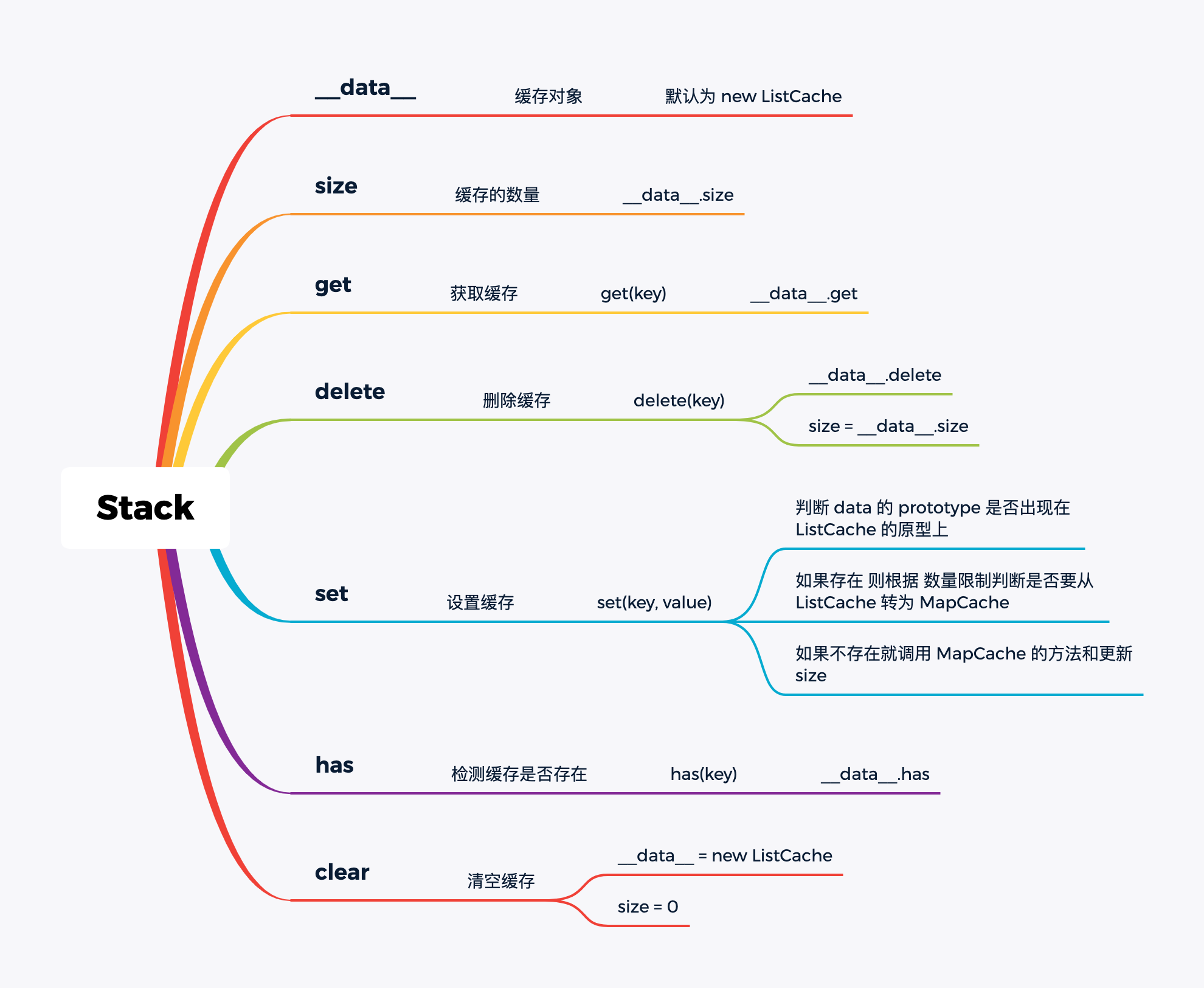# Stack
# Description
创建一个堆栈缓存对象来存储键值对
# Params
{Array} [entries] -- 要缓存的键值对
# Depend
import ListCache from './ListCache.js'
import MapCache from './MapCache.js'
# Code
const LARGE_ARRAY_SIZE = 200
class Stack {
/**
* Creates a stack cache object to store key-value pairs.
*
* @private
* @constructor
* @param {Array} [entries] The key-value pairs to cache.
*/
constructor(entries) {
const data = this.__data__ = new ListCache(entries)
this.size = data.size
}
/**
* Removes all key-value entries from the stack.
*
* @memberOf Stack
*/
clear() {
this.__data__ = new ListCache
this.size = 0
}
/**
* Removes `key` and its value from the stack.
*
* @memberOf Stack
* @param {string} key The key of the value to remove.
* @returns {boolean} Returns `true` if the entry was removed, else `false`.
*/
delete(key) {
const data = this.__data__
const result = data['delete'](key)
this.size = data.size
return result
}
/**
* Gets the stack value for `key`.
*
* @memberOf Stack
* @param {string} key The key of the value to get.
* @returns {*} Returns the entry value.
*/
get(key) {
return this.__data__.get(key)
}
/**
* Checks if a stack value for `key` exists.
*
* @memberOf Stack
* @param {string} key The key of the entry to check.
* @returns {boolean} Returns `true` if an entry for `key` exists, else `false`.
*/
has(key) {
return this.__data__.has(key)
}
/**
* Sets the stack `key` to `value`.
*
* @memberOf Stack
* @param {string} key The key of the value to set.
* @param {*} value The value to set.
* @returns {Object} Returns the stack cache instance.
*/
set(key, value) {
let data = this.__data__
if (data instanceof ListCache) {
const pairs = data.__data__
if (pairs.length < LARGE_ARRAY_SIZE - 1) {
pairs.push([key, value])
this.size = ++data.size
return this
}
data = this.__data__ = new MapCache(pairs)
}
data.set(key, value)
this.size = data.size
return this
}
}
# Analyze

Stack 作为一个缓存 键值对的类 ,其数据结构如图所示, 返回的数据结构为
// 超过 最大限制 LARGE_ARRAY_SIZE
Stack {
__data__: MapCache {
size: 29,
__data__: { hash: [Hash], map: [Map], string: [Hash] }
},
size: 29
}
// 未超过
Stack {
__data__: ListCache {
__data__: [
[Array], [Array],
[Array], [Array],
[Array], [Array],
[Array]
],
size: 7
},
size: 7
}
提供了 get set delete clear has 5个方法
# constructor
- 设置
this.__data__ = new ListCache(), 传入 键值对 数组 - 拿到
__data__.size, 更新到this上 - 在这里有一点需要注意,在初始化时,并不会判断传入的 数据量的多少,即使一开始传入了超过
199的数据限制,也是会使用ListCache,并不会直接使用MapCache,只有在set时才会进行判断转换
# get、has、delete
因为 this.__data__ 本身就是 new ListCache 或者 new MapCache 出来的实例,所以可以直接调用对应的 方法
delete 在这里不同的是,ListCache 和 MapCache 都是根据删除的结果更新的 size, Stack 直接取 __data__.size 更新即可
# set
通过 key value 设置键值对,并且维护更新 size 属性
- 判断
__data__的prototype是否出现在ListCache的原型上 - 如果出现了 在拿到
__data__.__data__, 也就是ListCache中的数据数组,判断 length 是否小于最大限制 199 - 如果小于则直接
push进数组,size更新为++ListCache.size- 这里没有直接使用 ListCache 的set ,可能是出于性能的考虑, ListCache.set 进行了数据的判重
- 这里没有进行数据判重,可能是因为
Stack是内部方法,在使用过程中会尽量避免数据重复问题 - 因为没有使用
ListCache.set,不会触发ListCache.size更新, 所以需要手动更新ListCache.size并赋值给外部使用
- 如果超过了最大限制,则直接将
__data__转换为MapCache来使用,将ListCache的实例数据传递即可 - 之后则会调用
MapCache.set来进行数据更新和size维护
# clear
- 更新 size 属性为 0
- 设置
__data__为初始值(new ListCache)
# Remark
# Example
对于数据结构如下,如果超过了 199 则会转为 MapCache 结构,调用其方法,具体示例可查看对应源码分析章节
// 超过了
Stack {
__data__: MapCache {
size: 29,
__data__: { hash: [Hash], map: [Map], string: [Hash] }
},
size: 29
}
// 未超过
Stack {
__data__: ListCache {
__data__: [
[Array], [Array],
[Array], [Array],
[Array], [Array],
[Array]
],
size: 7
},
size: 7
}